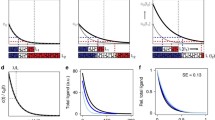Abstract
A previously investigated basic model (System B) for the study of signaling morphogen gradient formation that allows for reversible binding of morphogens (aka ligands) with signaling receptors, degradation of bound morphogens and diffusion of unbound morphogens is extended to include the effects of membrane-bound non-signaling molecules (or non-receptors for short) such as proteoglycans that bind reversibly with the same morphogens and degrade them. Our main goal is to delineate the effects of the presence of non-receptors on the existence and properties of the steady-state concentration gradient of signaling ligand–receptor complexes. Stability of the steady-state morphogen gradients is established and the time to reach steady-state behavior after the onset of morphogen production will be analyzed. The theoretical findings offer explanations for observations reported in several previous experiments on Drosophila wing imaginal discs.
Similar content being viewed by others
References
Bellin, R., Capila, I., Lincecum, J., Park, P.W., Reizes, O., Rernfield, M.R., 2003. Unlocking the secrets of syndecans: Transgenic organisms as a potential key. Glycoconjugate J. 19, 295–304.
Cadigan, K.M., Fish, M.P., Rulifson, E.J., Nusse, R., 1998. Wingless repression of Drosophila frizzled 2 expression shapes the Wingless morphogen gradient in the wing. Cell 93, 767–777.
Eldar, A., Dorfman, R., Weiss, D., Ashe, H., Shilo, B.Z., Barkai, N., 2002. Robustness of the BMP morphogen gradient in Drosophila embryonic patterning. Nature 419, 304–308.
Eldar, A., Rosin, D., Shilo, B.Z., Barkai, N., 2003. Self-enhanced ligand degradation underlies robustness of morphogen gradients. Dev. Cell 5, 635–646.
Entchev, E.V., Schwabedissen, A., Gonzalez-Gaitan, M., 2000. Gradient formation of the TGF-beta homolog Dpp. Cell 103, 981–991.
Fujise, M., Takeo, S., Kamimura, K., Matsuo, T., Aigaki, T., Izumi, S., Nakato, H., 2003. Dally regulates Dpp morphogen gradient formation in the Drosophila wing. Development 130, 1515–1522.
Gurdon, J.B., Bourillot, P.Y., 2001. Morphogen gradient interpretation. Nature 413, 797–803.
Jackson, S.M., Nakato, H., Sugiura, M., Jannuzi, A., Oakes, R., Kaluza, V., Golden, C., Selleck, S.B., 1997. Dally, a Drosophila glypican, controls cellular responses to the TGF-beta related morphogen, Dpp. Development 124, 4113–4120.
Kao, J., Nie, Q., Teng, A., Wan, F.Y.M., Lander, A.D., Marsh, J.L., 2003. Can morphogen activity be enhanced by its inhibitors? In: K.J. Bathe (Ed.), Proceeding of the 2nd MIT Conference on Computational Mechanics. MIT Press, Cambridge, MA, pp. 1729–1734.
Kerszberg, M., Wolpert, L., 1998. Mechanisms for positional signalling by morphogen transport: A theoretical study. J. Theor. Biol. 191, 103–114.
Lander, A.D., Nie, Q., Wan, F.Y.M., 2002. Do morphogen gradients arise by diffusion? Dev. Cell 2, 785–796.
Lander, A.D., Nie, Q., Wan, F.Y.M., Xu, J., 2003. Diffusion and morphogen gradient formation, Part I—extracellular formulation, submitted for publication.
Lander, A.D., Nie, Q., Vargas, B., Wan, F.Y.M., 2005a. Aggregation of distributed sources in morphogen gradient formation. Stud. Appl. Math. 114, 343–374.
Lander, A.D., Nie, Q., Wan, F.Y.M., 2006. Internalization and end flux in morphogen gradient formation. J. Comp. Appl. Math., 190, 232–251.
Lander, A.D., Nie, Q., Wan, F.Y.M., 2005b. Spatially distributed morphogen production and morphogen gradient formation. Math. Biosci. Eng. (MBE) 2, 239–262.
Lander, A.D., Wan, F.Y.M., Elledge, H.M., Mizutani, C.M., Bier, E., Nie, Q., 2005c. Diverse paths to morphogen gradient robustness, submitted for publicaiton.
Lecuit, T., Cohen, S.M., 1998. Dpp receptor levels contribute to shaping the Dpp morphogen gradient in the Drosophila wing imaginal disc. Development 125, 4901–4907.
Lei, J., Wan, F.Y.M., Lander, A.D., Nie, Q., 2005. On robustness of morphogen gradients, submitted for publication.
Lin, X., 2004. Function of heparan sulfate proteoglycans in cell signaling during development. Development 131, 6009–6021.
Lou, Y., Nie, Q., Wan, F.Y.M., 2004. Nonlinear eigenvalue problems in the stability analysis of morphogen gradients. Stud. Appl. Math. 113, 183–215.
Lou, Y., Nie, Q., Wan, F.Y.M., 2005. Effects of Sog on Dpp–receptor binding. SIAM J. Appl. Math., 65, 1748–1771.
Mizutani, C.M., Nie, Q., Wan, F.Y.M., Zhang, Y.-T., Vilmos, P., Bier, E., Marsh, J.L., Lander, A.D., 2005. Formation of the BMP activity gradient in the Drosophila embryo. Dev. Cell 8, 1–10.
Nie, Q., Lander, A.D., Wan, F.Y.M., 2004. Source of robustness in morphogen diffusion gradients. In: Proceedings of the AIMS — 5th International Conference on Dyn. System and Diff. Eqns. (Program & Abstracts), Pomona, p. 87.
Sattinger, D.H., 1972. Monotone methods in nonlinear elliptic and parabolic boundary value problems. Indiana Univ. Math. J. 21, 981–1000.
Shimmi, O., Umulis, D., Othmer, H., O’Connor, M., 2005. Facilitated transport of a Dpp/Scw heterodimer by Sog/Tsg patterns the dorsal surface of the Drosophila blastoderm embryo. Cell 120, 873–886.
Strigini, M., Cohen, S.M., 2000. Wingless gradient formation in Drosophila wing. Curr. Biol. 10, 293–300.
Teleman, A.A., Cohen, S.M., 2000. Dpp gradient formation in the Drosophila wing imaginal disc. Cell 103, 971–980.
Vergas, B., 2006. Leaky boundaries and morphogen gradients, Ph.D. dissertation, Dept. of Math., Univ. of Calif., Irvine, Dec. 2006.
Author information
Authors and Affiliations
Corresponding author
Rights and permissions
About this article
Cite this article
Lander, A.D., Nie, Q. & Wan, F.Y.M. Membrane-Associated Non-Receptors and Morphogen Gradients. Bull. Math. Biol. 69, 33–54 (2007). https://doi.org/10.1007/s11538-006-9152-2
Received:
Accepted:
Published:
Issue Date:
DOI: https://doi.org/10.1007/s11538-006-9152-2




